The Foundation of Freedom is the Courage of Ordinary People History  On Line On Line
|
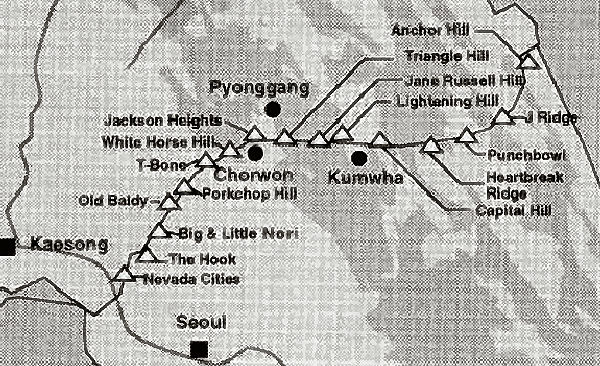 |
January 1, 1952 ... THE KILLING GROUNDS ... January 1, 1953 | |
STALEMATE: On New year's Day, 1952, a year and a half of slaughter still lay ahead.By July of 1951 we had finally driven the enemy back north of the 38th Parallel enough to establish a defensible border, and try to end the war by negotiation. As the Peace Talks dragged on, the war became largely exchanges of enormous volumes of artillery fire, equal to anything in WWI, with occasional savage fighting at a series of Outposts across Korea.
|
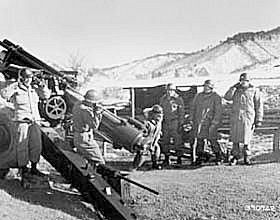
|
Lt Col Leon B. Humphrey, CO 213th Field Artillery Battalion, pulls the lanyard on "north east gun" of Battery A to send the 100,000th round of ammunition fired by the 213th at Chinese Communist positions. L-r: Sgt. D.L. Christensen of Richfield, Utah; M/Sgt. A.E. Crawford of Tyler, Tex.; Colonel Humphrey, Capt. Charles H. Yarber of Louisville, Ky., CO, Battery A; Major Gerald C. Morgan of Sioux City, Iowa, Executive Officer, 213th Field Artillery Battalion; and Capt. John P. Lamb of St. George, Utah, Assistant S-3 Officer. |
Personnel of No. 4 gun, Battery "B", 999th Armored Field Artillery Battalion, U.S. Eighth Army, fire on enemy positions. Firing the weapon at far right is Cpl. Andrew L. Williams, Doro, Alabama. 23 February 1952. | 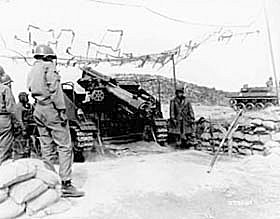 |
 |
Men of Battery B, 75th Field Artillery Battalion, U.S. Eighth Army, fire 155-mm howitzers at Communist positions, near Kumwha. 4 April 1952. |
Men of Battery C, 936th Field Artillery Battalion, U.S. Eighth Army, fire the 200,000 round of ammunition from their 155-mm howitzer during action against the Chinese Communist forces in Korea. 12 April 1952. | 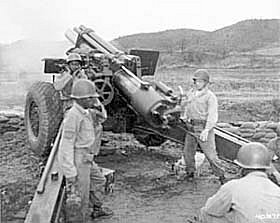 |
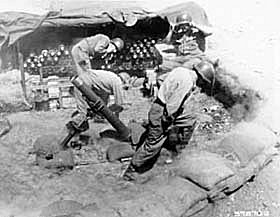 |
A 4.2-inch mortar crew of the Heavy Mortar Company, 179th Regiment, 45th U.S. Infantry Division, fires on Communist positions, west of Chorwon, Korea. 5 May 1952. |
Brigadier General Kenneth S. Sweaney, CG, X U.S. Corps Artillery, pulls the lanyard on the howitzer to fire the 150,000th round of ammunition used by men of Battery B, 955th Field Artillery Battalion, U.S. Eighth Army. 18 May 1952. | 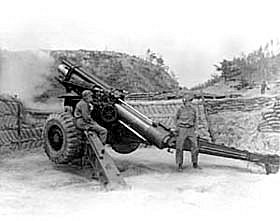 |
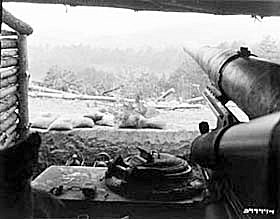 |
Communist-held territory from the hillside position of an eight-inch self propelled howitzer on Hill #857. 19 May 1952. |
An 8-inch howitzer is fired by members of Battery A, 17th FA Bn., 45th U.S. Inf. Div., north of Yonchon, Korea. 27 May 1952. | 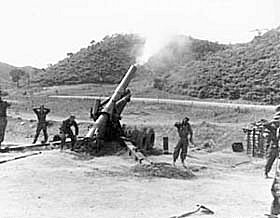 |
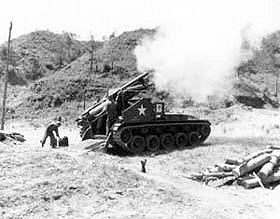 |
A 155-mm howitzer acting as "base gun" for Battery A, 92nd Armored Field ArtilleryBattalion, U.S. Eighth Army, firing adjusting rounds near Kumhwa, Korea. 8 June 1952. |
Infantrymen of the Heavy Mortar Co., 1st Platoon, 35th Infantry Regiment, 25th U.S. Infantry Division, fire the 4.2-inch Heavy mortar on Communist hill positions in the Mung Dung-ni Valley. 10 August 1952. | 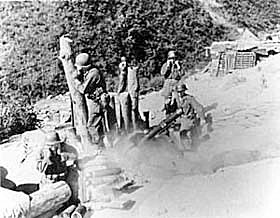 |
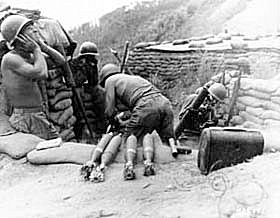 |
Members of the 81-mm Mortar Platoon, Co. D, 2nd Battalion, 5th Infantry Regiment, U.S. Eighth Army, blast Communist positions in Punchbowl, Korea. 12 August 1952. |
A gun crew firing an eight-inch self-propelled howitzer at Communist hill positions after receiving a fire mission from Co. A, 1st Battalion, 5th Infantry Regiment, U.S. Eighth Army, west of Punchbowl. 13 August 1952. | 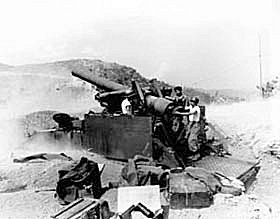 |
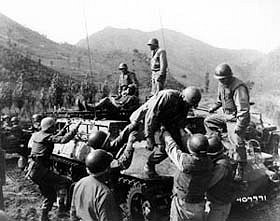 |
Medical corpsmen of the 1st Battalion Aid Station, 31st Inf. Regt, 7th U.S. Inf. Div., assist in helping wounded infantrymen of Companies D and L, 31st Regiment, following the fight for Hill 598 near Kumhwa. 14 October 1952. |
Wounded infantrymen of Co L, 31st Inf. Regt., 7th U.S. Inf. Div., light up cigarettes after receiving first aid following a battle for Hill 598, near Kumhwa. 14 October 1952. | 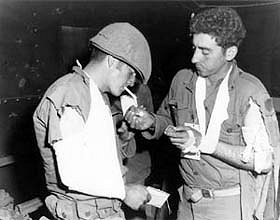 |
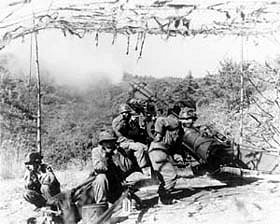 |
A gun crew of the 88th Field Artillery, ROK Army, fires a 155-mm howitzer at Communist positions during action against the Chinese Communist forces in the Shanghi Heights Area, west of Chorwon. 30 October 1952. |
And so 1952 ground painfully to its bloody end. Necessary bloodshed because negotiation between governments requires time-consuming compromise and discussion. Necessary bloodshed for the United Nations fighting forces because it would one day ensure a free South Korea. Ongoing tragedy for those poor souls who had to shed that blood, on all sides. |
















